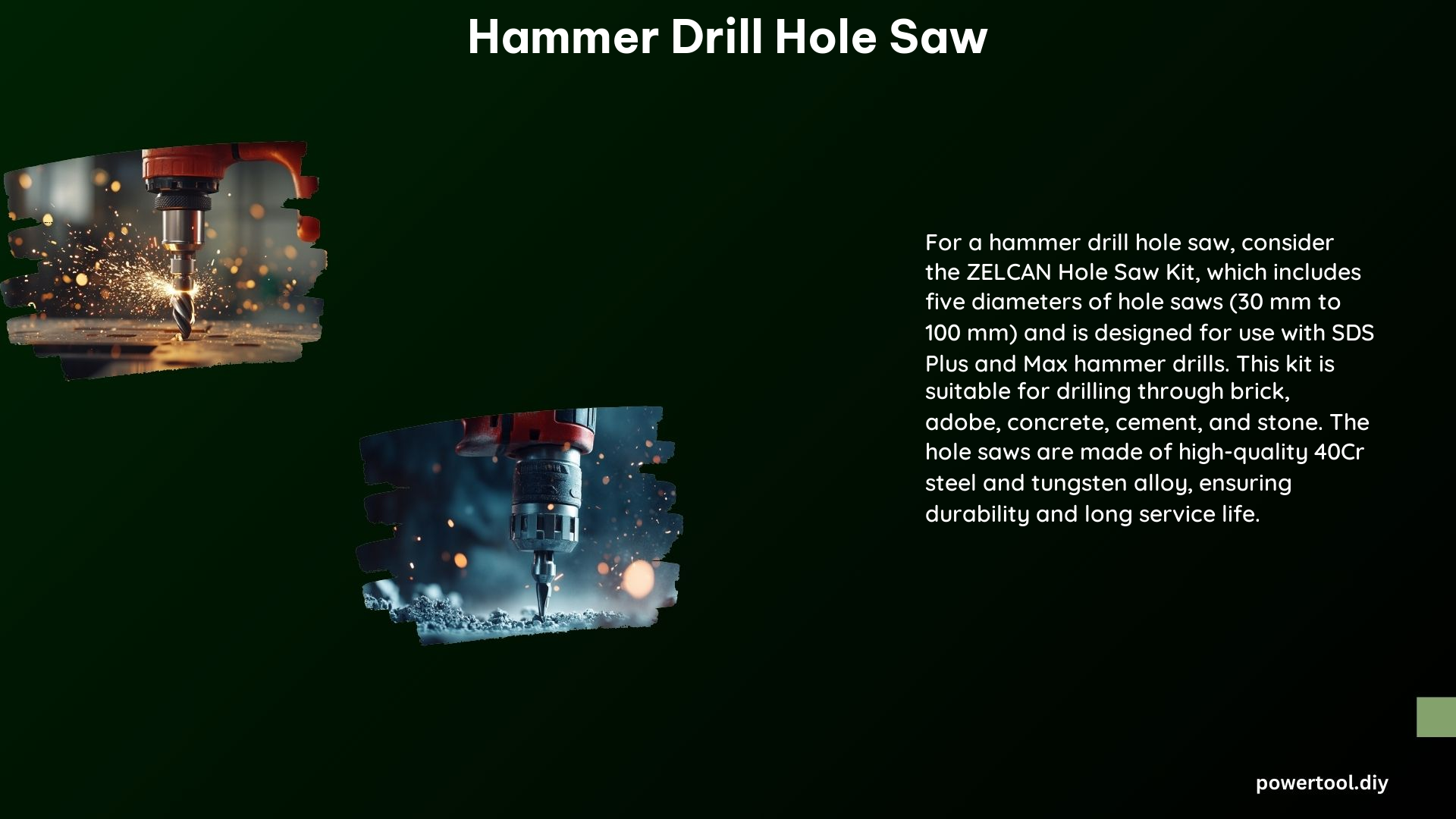A hammer drill hole saw is a versatile power tool designed for drilling large holes in a variety of materials, including wood, concrete, brick, and stone. This comprehensive guide will provide you with the technical details, best practices, and safety considerations to ensure efficient and successful drilling projects using a hammer drill hole saw.
Best Drill Setting
To maximize the performance and safety of your hammer drill, it’s crucial to set up the drill correctly. Here are the key steps to follow:
-
Drill Mode Selection: For drilling through masonry materials like concrete, brick, or stone, use the hammer drill mode. This mode combines rotational force with a hammering action, allowing the drill to effectively penetrate hard surfaces. For softer materials like wood, use the standard rotary drill mode.
-
Speed Adjustment: The optimal drill speed varies depending on the material being drilled. Generally, use a slower speed for harder materials like concrete (around 500-800 RPM) and a faster speed for softer materials like wood (800-1,200 RPM). Adjusting the speed helps prevent overheating and ensures a clean, efficient drilling process.
-
Pressure Application: Apply steady, controlled pressure to the drill, gradually increasing as needed. Avoid excessive force, as this can cause the drill to stall or kickback, potentially leading to damage or injury.
Preventing Stalling or Kicking

To prevent stalling or kicking when using a hammer drill hole saw, follow these guidelines:
-
Correct Drill Bit Selection: Ensure that the hole saw you’re using is designed for the specific material you’re drilling. Compatibility between the hole saw and the material is crucial for efficient and safe operation.
-
Maintaining a Steady Grip: Hold the drill firmly with both hands, keeping your arms straight and your body balanced. This stable grip will help you maintain control and prevent the drill from kicking back.
-
Monitoring Drill Speed and Pressure: Continuously monitor the drill’s speed and the pressure you’re applying. Adjust as needed to avoid overheating or stalling the drill.
-
Drill Bit Maintenance: Regularly clean and sharpen the hole saw to maintain its effectiveness and prevent stalling or binding during the drilling process.
Drilling Techniques for Different Materials
The drilling techniques vary depending on the material you’re working with. Here are the recommended approaches for common materials:
- Wood:
- Use the rotary drill mode.
- Apply gentle to moderate pressure.
-
Use a slower speed for larger hole sizes (typically 500-800 RPM).
-
Concrete and Masonry:
- Use the hammer drill mode.
- Apply moderate to heavy pressure.
-
Use a slower speed (typically 500-800 RPM) to avoid overheating the drill and the hole saw.
-
Brick and Stone:
- Use the hammer drill mode.
- Apply heavy pressure.
- Use a slower speed (typically 500-800 RPM) to prevent overheating and ensure a clean, efficient drilling process.
Technical Specifications
When selecting a hammer drill and hole saw, consider the following technical specifications:
-
Drill Type: Choose between a cordless or corded hammer drill based on your power requirements and convenience preferences. Cordless drills offer greater mobility, while corded drills provide a consistent power supply.
-
Power: Opt for a hammer drill with sufficient power, measured in volts or amps, to handle the material and hole size you’ll be drilling.
-
Speed Settings: Look for a hammer drill with adjustable speed settings, allowing you to tailor the drill’s performance to the specific material and hole size.
-
Hole Saw Size and Material: Select hole saws that are appropriate for the material you’ll be drilling and the desired hole size. Common hole saw sizes range from 1/2 inch to 6 inches in diameter.
-
Shank Type: Ensure that the hole saw you choose has an SDS-Plus or SDS-Max shank, which is compatible with most hammer drills.
Recommended Products
Here are some popular and highly-rated hammer drill hole saw products to consider:
-
Milwaukee Tool M18 18V Lithium-Ion Cordless Hammer Drill/Impact Driver Combo Kit: This versatile kit includes a powerful 18V cordless hammer drill and an impact driver, providing the necessary tools for a wide range of drilling and fastening tasks.
-
Hanperal Hole Saw Kit for SDS Plus: This comprehensive kit includes a variety of hole saws with SDS-Plus shanks, suitable for drilling through concrete, brick, and other masonry materials.
-
ZELCAN Hole Saw Kit for SDS Plus and Max Hammer Drills: This kit offers a range of hole saws compatible with both SDS-Plus and SDS-Max hammer drills, catering to a broader spectrum of drilling needs.
-
Spyder Products 2″ Tungsten Carbide Tipped Hole Saw: This high-quality hole saw features a tungsten carbide tip, providing exceptional durability and performance when drilling through tough materials like concrete and brick.
Safety Precautions
Safety should always be the top priority when using a hammer drill hole saw. Follow these essential safety guidelines:
-
Wear Protective Gear: Equip yourself with safety glasses, gloves, and a dust mask to protect your eyes, hands, and respiratory system from debris and dust generated during the drilling process.
-
Ensure Proper Ventilation: Work in a well-ventilated area to minimize the inhalation of harmful dust and particles.
-
Follow Manufacturer Instructions: Carefully read and adhere to the manufacturer’s instructions for the specific hammer drill and hole saw you’re using. This will help you operate the tools safely and effectively.
By following the best practices, technical specifications, and safety precautions outlined in this comprehensive guide, you’ll be well-equipped to tackle a wide range of drilling projects using a hammer drill hole saw. Remember to always prioritize safety and consult the manufacturer’s instructions for optimal performance and longevity of your tools.
References
- https://www.reddit.com/r/Tools/comments/1782cu5/which_drill_do_i_need_to_buy_for_4_holesaw_for/
- https://www.homedepot.com/b/Tools-Power-Tool-Accessories-Drill-Bits-Hole-Saws-Hole-Saw-Arbors/SDS-Plus/N-5yc1vZc9c1Z1z18037
- https://www.amazon.com/Hanperal-Shank-Cutter-Concrete-Cement/dp/B01MFGT841
- https://www.amazon.com/ZELCAN-Hole-Saw-Kit/dp/B09SFT3P85
- https://spyderproducts.com/2-tungsten-carbide-tipped-hole-saw/
